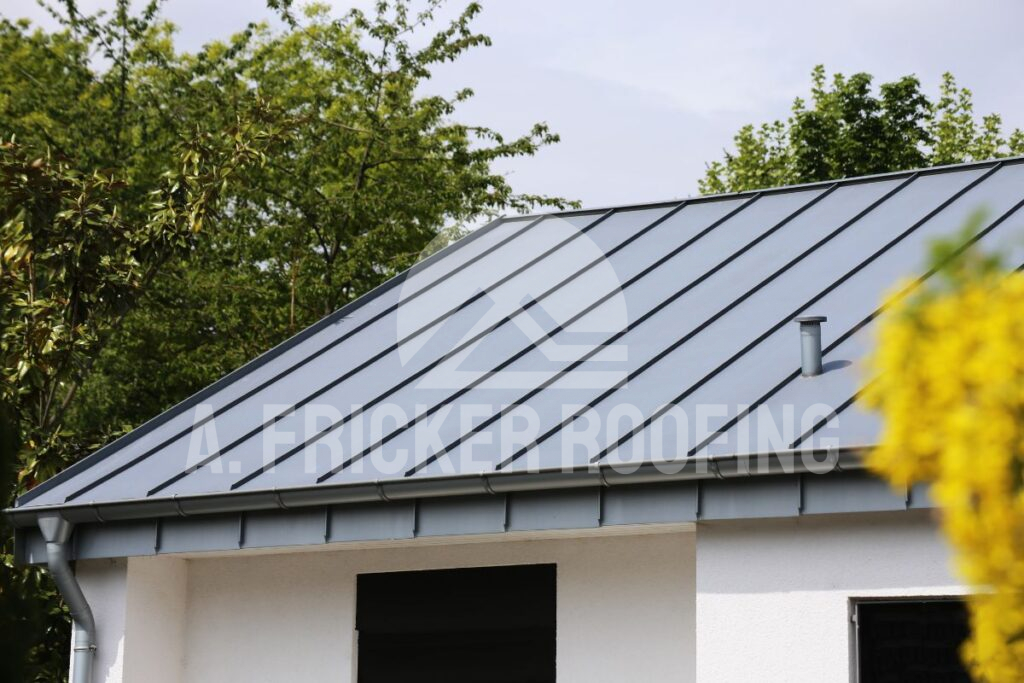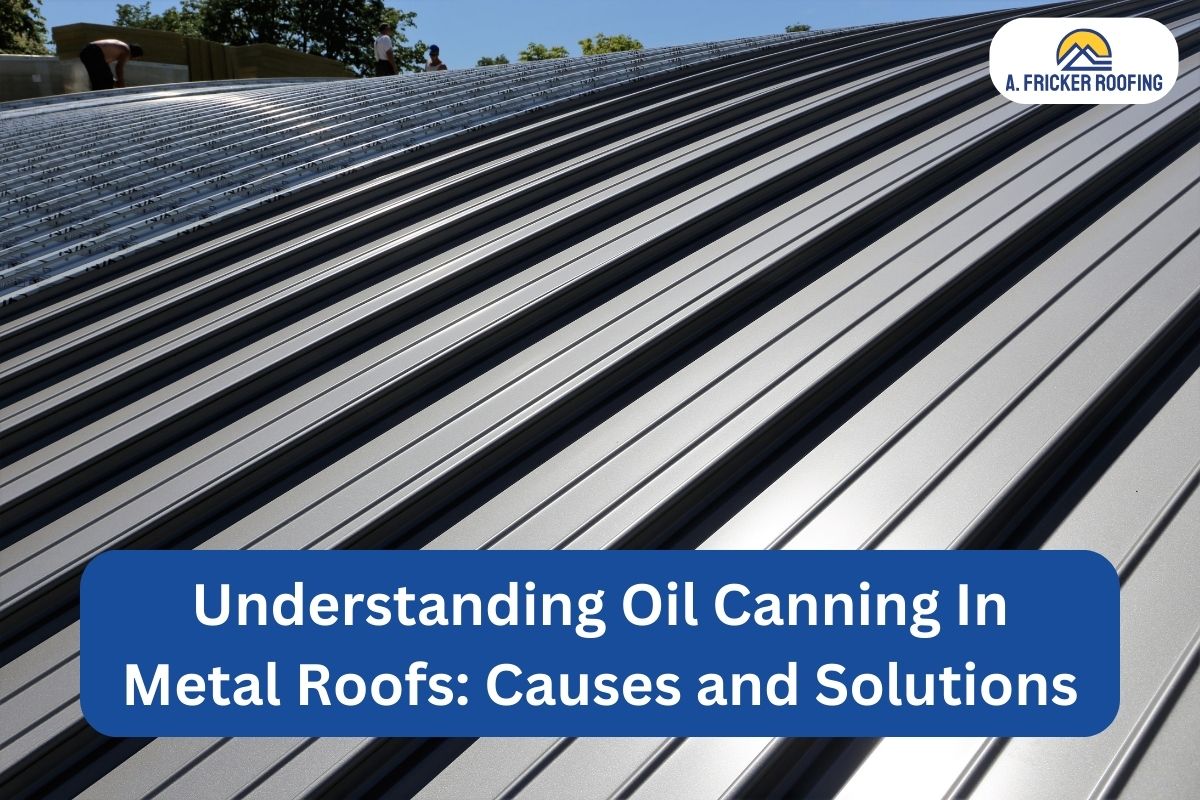Do you ever notice wave-like patterns spread over one section or more on your metal roof? This effect is known as metal roof oil canning. If you have a metal roof installed or are looking to install one, you might be wondering: what is metal roof oil canning, and does oil canning go away? If you want to know the answers to these questions and more, read this blog post through the end.
What Is Metal Roof Oil Canning?

Metal roof oil canning is an effect that can be caused by a variety of reasons, including thermal expansion and poor installation. Metal roofs with oil canning appear to be wavy, rippled, and distorted when seen from different angles. Since metal roofs undergo thermal expansion and contraction under temperature extremes, they are more likely to look distorted on flat surfaces, making them appear dull or shiny depending on where you are standing.
This distortion might make the metal roofing panels appear like they have been oil-polished. However, it is important to note that oil canning on metal roofs has nothing to do with their performance or functionality, it is only a cosmetic issue.
What Causes Oil Canning On Metal Roofs
There are many factors that contribute to metal roof oil canning, including the following.
1. Temperature Extremes
Oil canning can be caused by extreme temperature fluctuations. Throughout their lifespan, metal roofs are exposed to varying temperatures that cause them to expand and contract, resulting in metal roof oil canning, rippling, and distortion. This effect is especially visible when sun rays hit the roofing panels.
2. Low Quality and Thin Metal Roofing Panels
Lower quality or thin metal roofing panels are more subject to oil canning, as they more frequently flex according to temperature, whereas high quality and thicker metal roofing panels are less prone to expand and contract. You can prevent oil canning by installing high quality roofing panels that are more likely to resist thermal fluctuations.
3. Poor Installation and Workmanship
Poor installation and improper handling of metal panels, regardless of their material quality, can cause panel misalignment and oil canning. Panels that are not handled and fastened properly at the time of installation can appear distorted and bucked. Sometimes, over tightened or loosely attached panels move from their initial position. All these improper installation techniques give rise to a problem of oil canning that can’t be easily fixed.
4. Faulty Manufacturing Process
During or after the manufacturing process, the metal panels are coiled and sheeted by a roller. This process requires proper stress distribution throughout the panel in order to achieve the desired look and appeal. If not done correctly, this process can just do the opposite of what was intended. Uneven stress distribution of panels can cause the oil canning effect.
5. Uneven Roof Deck
The role of the roof deck isn’t only limited to supporting roofing materials, it is also responsible for your roof’s aesthetic appeal. As in the case of a metal roof, an uneven or bumpy roof deck can stress the metal panels, causing depressions that may look dull or too bright when seen from different angles – ultimately giving rise to the oil canning effect.
Often, the problems aren’t the poor panel installation and improper handling, it is the irregular deck and substrate lying underneath the panels. Therefore, when doing a roof inspection, make sure you check the roof deck to make sure it is flat and stable.
How To Fix Metal Roof Oil Canning
There are some methods that can reduce and mask the visibility of the oil canning effect. However, it is essential to consult a professional metal roofing expert before performing any following actions.
1. Coating the Metal Roofing Panels
Applying an expert’s recommended metal roof coating can reduce and mask the visibility of oil canning. Since metal roof oil canning is an aesthetic concern and not of performance and functionality, you can maintain the aesthetics of your metal roof by painting or applying the right coating.
Applying the right metal roof coating can also limit the panel’s thermal movement. However, make sure you adjust the panels before applying any coating, as resolving the underlying issue is more necessary than hiding it.
2. Adjust The Metal Roofing Panels
Inspect your roof for misaligned panels and over tightened or loosely attached fasteners with professional assistance. Taking this step can alleviate the localized oil canning effect.
3. Replace The Panels In Question
One advantage of having metal roofs is that you can replace the old panels with new ones, under the condition that the new ones should match the existing ones. If the oil canning is severe, you can replace the part of the metal roof that has the effect.
However, this time, ensure you install them correctly so that this issue doesn’t arise again in the future. Also, it’s important to hire professional roofers so that you never deal with metal roofing problems.
If you’re looking for a contractor, check out these eight signs to consider when hiring a metal roofing company.
How To Prevent The Oil Canning Effect On Metal Roofs
Before you tackle this issue in the future, make sure you take the necessary preventive measures to minimize the oil canning effect.
1. Allow Space For Thermal Movement
During the metal roof installation, leaving adequate space for thermal movement is an expert technique. Because the rate of thermal movement in different metals varies, you must consult your professional roofer about the chosen metal. You can also select metal roofing systems with reflective coatings that minimize heat absorption, reducing thermal stress on the roof.
2. Choose High Quality and Thick Panels
As we now know, one of the major reasons behind oil canning is the width of the metal panels. Choosing thin and low quality panels will only accelerate the expansion of roofing panels, resulting in your roof showing oil canning. To counter this, prioritize quality and thickness when selecting metal panels for your roofing system. This proactive measure not only prevents oil canning but also contributes to the overall durability of the metal roof.
3. Ensure The Roof Deck Is Sturdy
As mentioned above, an irregular substrate can create localized stress points, contributing to distortions on the metal surface. Before the installation of metal panels, ensure that the roof deck is level and provides consistent support. The inconsistency in the roof deck not only results in oil canning but also increases the chances of water leaks, poor insulation, and reduced energy efficiency.
4. Provide Additional Support
Features such as stiffening ribs or corrugations help distribute stress more evenly across the panels. These design elements enhance the overall rigidity of the roofing system, minimizing the potential for visible distortions. Structural enhancements not only serve to prevent aesthetic concerns like oil canning but also contribute to the functionality of the roof.
By following these tips, you can minimize the chances of oil canning on your metal roof.
Contact The Professional Metal Roofing Experts In Tulsa, OK
If you are dealing with effects like oil canning on your metal roof, turn to the professionals at A. Fricker Roofing and Waterproofing in Tulsa, OK. The roofers at the company are proficient at solving residential and commercial metal roofing problems, whether related to oil canning or functional issues like water leaks. Contact us today at (918) 402-7167 for your metal roof installation or repair.

